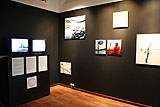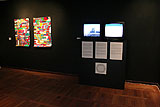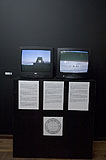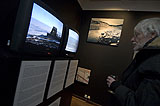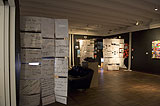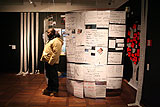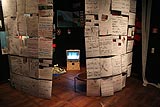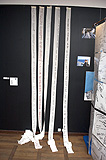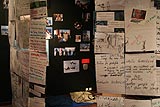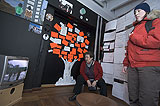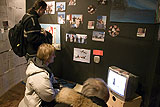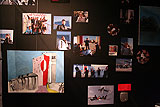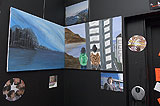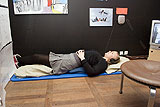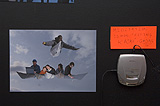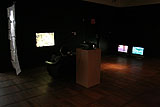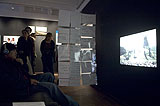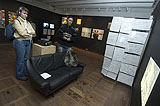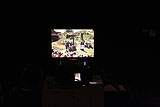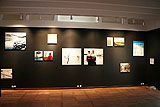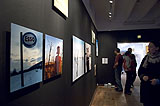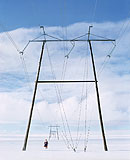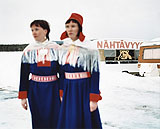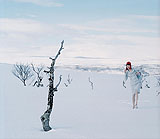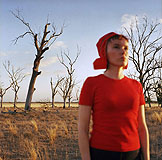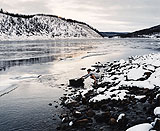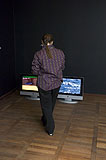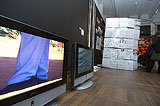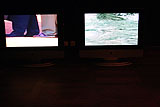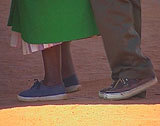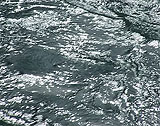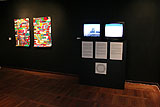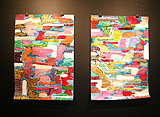
Contested Territories: Representing Postcolonial Interests
Greenland National Museum and Archives, Nuuk
April 21 – May 14, 2006
This exhibition, which took place in the Special Exhibits Gallery, focused on contemporary experiences with postcolonial societies and cultures. Identities were examined in their relationship to such factors as state, militarization, and globalization, but also in relationship to landscape and memory. The exhibition addressed questions of dependency and marginalization, and attempted to propose ways out of subordination.
The exhibition was accompanied by the film program Silver Screen Resistance.
Participating Artists / Organizations
Center for Land Use Interpretation (USA)
Katrine Dirckinck-Holmfeld, Humphrey Polepole & Ivaaq Poulsen in collaboration with Inuit Youth International (Denmark, Tanzania & Greenland)
Tamar Guimarães (Brazil/Denmark)
Marja Helander (Sámi, Finland)
Moshekwa Langa (South Africa/The Netherlands)
Click polar bear to see video tour of the exhibition (6:34 min.)
Dedicated to the increase and diffusion of information about how the nation’s lands are apportioned, utilized, and perceived.
The Center for Land Use Interpretation is an educational organization that produces public exhibits, displays, interpretive installations, and other programs that explore the relationship between humans and the physical landscape. The Center was established in 1994 and is currently headquartered in Los Angeles, with regional offices and field locations in New York, Wendover, Utah, and the Mojave Desert. The center works with local, national, and international cultural institutions in the production of public programs that deepen the collective understanding of the nature and extent of mankind’s interaction with the earth’s surface. [Center for Land Use Interpretation]
The Center for Land Use Interpretation contributed with a new project entitled “Ultima Thule” produced specifically for Rethinking Nordic Colonialism in 2006. CLUI writes about the project: “Heading towards the poles, space/time folds onto itself, and disparate worlds merge into one another. In the Arctic, converging lines of longitude catch nations in a cartographic net, pulling the competing powers of the Northern hemisphere into collision. It is here, then, where the most extreme electronic fortresses and entrenchments were laid between East and West. Engaged in a war of silence, massive sensitive antennas watched for movements, straining to detect in the invisible spectrum. Dark deadly vessels glided silently beneath the ice, hair-triggered to strike with a terminal conflagration. The Arctic was the front line for the cold, Cold War. And history continues.
The American air base at Thule, Greenland was built hurriedly in 1951, but by 1961 its mission had moved from planes to space. Today, the base exists to support two radar and telemetry stations, both established in the early 1960s, at separate locations a few miles from the main base, and both expanded and metamorphosed by evolutions in technology. Both of these facilities are among those considered most critical to America’s defense, and if they didn’t exist at Thule, they would be duplicated somewhere nearby. Their role is now expanding with the United States’ Missile Defense program.” [Center for Land Use Interpretation]
To view wall text from “Ultima Thule,” click here.
Center for Land Use Interpretation, Installation view of “Ultima Thule” (2006). 2 x videos on podium, each 2 min. loops. Photo: © Eija Mäkivuoti. Courtesy of Center for Land Use Interpretation
Center for Land Use Interpretation, Details of “Ultima Thule” (2006). Photo: © Knud Josefsen. Courtesy of Center for Land Use Interpretation
Lives and works in Dar es Salaam, Tanzania
Lives and works in Nuuk, Greenland
Founded 2001 in Nuuk, Greenland. Based in Nuuk
Katrine Dirckinck-Holmfeld is a MFA candidate at The Royal Danish Academy of Fine Arts in Copenhagen. Recently, she has been living in Beirut, Lebanon, where she has continued her studies at Acadèmie Libanaise des Beaux Arts (ALBA) and has followed the program of an art teacher in one of the kinder gardens of Ghassan Kanafani’s Cultural Foundation in the Palestinian camps in Lebanon. Katrine considers herself a cultural worker informed by feminist and critical theory. Her artistic investigations take on various directions and forms, from activist strategies to more conventional artistic practices. But in large, her projects have more or less been turning around artistic education and the creation of a plural public sphere. She has co-organized, curated, and published the Women’s 96th Anniversary (2004), a feminist subversion of the 250th Anniversary of The Royal Danish Academy of Fine Arts in Copenhagen. Other than participating in a number of not-worth-mentioning exhibitions in Denmark, Mexico, and Lebanon, she has written articles and reviews and held workshops, latest “Nationalism, Cultural Territories and the Role of Cultural Producers” at the Next Stop Summer University in Vukovar, Croatia, 2005. [Katrine Dirckinck-Holmfeld]
Humphrey Polepole is the current Secretariat Director of the Tanzania Youth Coalition (TYC), the biggest youth movement in Tanzania. He is also the Steering Committee Member of the Sustainability Watch Network under Tanzania Coalition on Sustainable Development (TCSD). He has recently been elected to join the Steering Committee of the Social Watch preparation at the East African sub-region and is a member of Policy Advisory Board of MS Tanzania. Polepole has held several positions at local, national, and international levels in the civil society and in the United Nations as a United Nations Environment Programme Associate Youth Advisor for Africa. Several times, he has been part of the United Republic of Tanzania (URT) government delegation, attending high-level meetings at the United Nations Framework Convention on Climate Change (UNFCCC). He has also served the World Youth Organization on Climate Change as a Southern region youth representative. In addition, Polepole has taken an active role in the Rio+10 NGO process in the South and is a Chair of the East African Youth Coalition (EAYC) on Sustainable Development. He has taken a lead role in several reviews of policies, including the National Strategy for Growth and Reduction of Poverty (NSGRP) and the post review and evaluation process for the Johannesburg Summit, focusing on the Tanzania Rio+10 partners and the East African Rio+10 NGO Coalition participation. He was selected to join a six people taskforce to anticipate the future of the sustainable development NGO process in East Africa, being the youngest member of the team. He has worked on policy issues as an analyst at local, national, and international levels. Furthermore, he is a trainer on research methodologies and has conducted trainings on Participatory Rural Appraisal (PRA), Appreciative Inquiry (AI), and Participatory Learning and Action for Community Development (PLA-CD). [Humphrey Polepole]
Ivaaq Poulsen is a professional diver and active member of Inuit Youth International (IYI). IYI is a grass roots organization, which was founded during a general assembly in Nuuk in 2001. From the very beginning, the goal of IYI has been to work for and involve youth in a progressive national and local collaboration in a time of great turbulence. IYI has organized several events on the questions of Inuit identity, spirituality, and how to overcome the barriers of cultural taboos such as suicide, homosexuality, and so forth. [Ivaaq Poulsen]
Katrine Dirckinck-Holmfeld, Humphrey Polepole, Ivaaq Poulsen, and Inuit Youth International contributed with “Youth Writes Back,” a community mobilizing project consisting of a workshop and a multimedia installation developed specifically for Rethinking Nordic Colonialism. In Dirckinck-Holmfeld’s words, “‘Youth Writes Back’” aimed to examine postcolonial situations from a youth and educational perspective. The project brought 17 young activists, artists, and educators from different postcolonial situations together in a workshop in order to discuss, intervene, and invent new methods of exploring how education has been used to reproduce the colonial hegemony, and how we through education as a creative process can reveal a deeper understanding of our different cultural values, environments, and perspectives on ‘glocal’ issues. In Scandinavia, and specifically in Denmark, there exists a very limited education on the colonial past and present of those countries. This could be referred to as powerful ignorance. The Danes somehow still perceive of themselves not as colonizers but as ‘aid-administrators,’ who came to the rescue of our ‘poor neighbors.’ This perception of the people of Greenland as not being able to help themselves does not reflect reality, but serves to smooth over the conscience of the colonizers. In order to produce other images and stories opposed to the ruling, the workshop participants went out into the city of Nuuk and its surroundings and investigated themes of ‘My City,’ ‘Language,’ and ‘Dig-I-dentity.’ All the material accumulated during the workshop was subsequently presented as a multimedia installation in the exhibition. In near future, we also hope to present the project on the UNESCO web portal for Young Digital Artists: http://portal.unesco.org/culture/en. [Katrine Dirckinck-Holmfeld]
To view workshop participant names, click ![]() here.
here.
To view wishes from the workshop, click ![]() here.
here.

Click polar bear to see PowerPoint presentation from the workshop (26 images)
To view “Nuuk York” video from the installation (8:43 min.), click polar bear

To listen to “Amia” audio track from the installation (5:16 min.), click polar bear

To listen to “Flying Kayak” audio track from the installation (5:48 min.), click polar bear
Katrine Dirckinck-Holmfeld, Humphrey Polepole & Ivaaq Poulsen in collaboration with Inuit Youth International, Installation view of “Youth Writes Back” (2006). Multimedia installation from the workshop “Youth Writes Back” held in Nuuk, April 10 – 14, 2006. Photo: © Knud Josefsen, Eija Mäkivuoti, and Innuteq Petersen. Courtesy of the artists
Tamar Guimarães graduated from Goldsmiths College, London in 2002 and was a guest at The Royal Danish Academy of Fine Arts in Copenhagen from 2002-04. She views her practice as a way of reflecting on the power relations underpinning social interactions and of considering the relationship between history and subjectivity in a postcolonial environment. [Tamar Guimarães]
Tamar Guimarães participated in Act 2 with “Jan Leton and the Archive,” a slide projection with voice-over from 2006 examining the story of the slave, Jan Leton, and the history of the Danish Triangular Trade. Guimarães describes the project as follows: “In the early 19th century, Jan Leton was given as a gift to the Bailiff of Skagen and lived there, as the Bailiff’s slave, until his death in 1827. Born in the West Indies, Leton’s death record is the only official document in which his presence in Skagen is marked in writing during his ‘lifetime.’ He is, however, mentioned periodically in local newspapers and local history accounts from 1877 onwards.
Sand drift was a threat to the communities in 19th century Northern Jutland. Less threatening now, large dunes still move fifteen centimeters every year. Part of the stories on Jan Leton tell how Jan, at the Bailiff’s services, planted the first forest which was successful in stabilizing the drifting sands. This forest became known as The Plantation.
A document in fiction form, ‘Jan Leton and the Archive’ is a narrative in which a researcher attempts to find out more about a man, who had arrived as a slave but was perhaps later freed, had been buried in the forest but was perhaps later dug up and reburied in the church grounds. In an attempt to unpack the archive and produce a critical document, the narrative tries to articulate the uncertainties of historical projects in general, as well as the more specific lack of coherence one encounters in the narratives concerning marginal figures and subaltern groups.
‘Jan Leton and the Archive’ was shown as a slide projection with voice-over at the second act of Rethinking Nordic Colonialism. The slides were part of Skagen’s local history archive collection and were taken during a performance of the local theater group (Egnsspil) in 1989 when they re-enacted Jan Leton’s arrival and life in Skagen.” [Tamar Guimarães]
To view handout text accompanying the installation, click ![]() here.
here.
To view DVD documentation extract of “Jan Leton and the Archive” (3 min.), click polar bear. Please use headphones
Tamar Guimarães, Installation view of “Jan Leton and the Archive” (2006). Color slide projection with English voice-over (mono sound), 24 min. Voice: Charlotte McGowan-Griffiths. Sound: Jasmine Guffond. Slides from Skagen local history archive and Egnsspil members. Photo: © Knud Josefsen, Eija Mäkivuoti, and Innuteq Petersen. Courtesy of the artist
Marja Helander is an artist of Sámi heritage. She originally graduated as a painter from the Lahti Institute of Fine Arts, Finland, in 1992. Using mostly photographs in her works, however, Helander went on to study photography at the University of Art and Design in Helsinki, where she graduated in 1999. In 1994, Helander was one of the ten finalists in the Foto Finlandia competition. Her work has been presented in solo and group exhibitions both in Finland and abroad, including the Hasselblad Center in Gothenburg, BildMuseet in Umeå, Charlottenborg Exhibition Hall in Copenhagen, and Galleri F15 in Moss, Norway. [Tone Olaf Nielsen]
Marja Helander participated in Act 2 with a series of older photographs and new paintings. She describes her contribution in the following words: “My photographs are based on my Sámi background. In them, I examine the conflict between the traditional Sámi way of life and modern society. My works also consider my own bi-cultural identity: my father is Sámi, but I was brought up in the south of Finland, far away from the Sámi land, tradition, and language. In the works, the viewer encounters a modern woman, who is totally lost in her traditional Lappish environment. She walks in the mountains, following the footsteps of her reindeer breeding ancestors, but doesn’t understand her position. The movements of the woman continue, but the frame of reference changes from Finland to Northern Norway, Russia, and Australia.” [Marja Helander]
Marja Helander, Installation view. Photo: © Eija Mäkivuoti and Knud Josefsen. Courtesy of the artist
Marja Helander, “Tourist Attractions, Finland” (2003). Chr. c-print, 70 x 85 cm. Courtesy of the artist
Moshekwa Langa is a visual artist working with drawings, installations, videos, paintings, and photography. He was born in South Africa and attended different government schools in the then Lebowa area, part of a series of homelands created for different ethnic groups with an education system tailored to fit people from those places. In 1989, Moshekwa enrolled in the former Max Stibbe Waldorf School (now called Ubuntu Centre) in the greater Pretoria region. The Waldorf School was based on the philosophies of Rudolf Steiner and the anthroposophical societies. Upon completing his high school studies, he spent two years in a period of introspection and experimentation. He made drawings and sculptural works and wrote texts pertaining to his life and situation in the dawning new country. He also worked as a contributing producer on an arts and culture program called The Works for the South African broadcasting corporation. From 1997-98, Langa then attended the Rijksakademie van beeldende kunsten in Amsterdam. He has participated in numerous public discussions and forums, television and radio specials, and his work has been presented in monographic and group exhibitions such as: The Johannesburg Biennale (1997), The Sao Paulo Biennale (1998), The Short Century: History and Liberation Movements in Africa 1945-1994 (Villa Stuck, 2001), Generation Z (P.S.1 Contemporary Art Center, 2002), Ars 01 (Kiasma, 2002), The 50th Venice Biennale (2003), Looking Both Ways (Museum for African Art, New York, 2003). His solo shows include: Live and in Person (The Renaissance Society, Chicago, 1998), Another Time, Another Place (The Goodman Gallery, Johannesburg, 2001), Present + Tense (Düsseldorf Kunstverein, 2004), Moshekwa Langa (Maxxi Museum, Rome, 2005), and The man who cast no shadows (Tache-Levy Gallery, Brussels, 2006). [Moshekwa Langa]
For Act 2, Moshekwa Langa contributed with the 2001 video work “Where do I begin” and two new drawings titled “Index: The Immorality Act” and “Index: Separate Development,” both from 2006. Langa describes both projects as follows:
“‘Where do I begin’ is a work on two screens: one shows the lower parts of people’s bodies getting on a bus, the other displays the movement of very blue water flowing in a river. One sees details of clothing and shoes of the people getting on the bus. There are no dialogues. The soundtrack consists of ambient noises and parts of the song ‘Where do I begin’ performed by Shirley Bassey, which has given the work its title.
Moshekwa Langa, Installation view of “Where do I begin” (2001). Two-channel video work, DVD, 4:30 min. Photo: © Eija Mäkivouti and Knud Josefsen. Courtesy of the artist
The new piece consists of two drawings made with Indian ink and acrylic on paper. Titled ‘Index: The Immorality Act’ and ‘Index: Separate Development,’ the drawings are made up of texts, names of people and places, and collage elements. The piece is an associative map of memories as well as private and public terms. The maps are colorful, subjective, and indecipherable.” [Moshekwa Langa]

